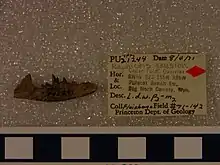Raphictis
Raphictis ("needle weasel") is an extinct genus of placental mammals from extinct subfamily Didymictinae within extinct family Viverravidae, that lived in North America during late Paleocene.[5][6][7]
| Raphictis | |
|---|---|
 | |
| lower jaw of Raphictis gausion | |
| Scientific classification | |
| Domain: | Eukaryota |
| Kingdom: | Animalia |
| Phylum: | Chordata |
| Class: | Mammalia |
| Superfamily: | †Viverravoidea |
| Family: | †Viverravidae |
| Subfamily: | †Didymictinae |
| Genus: | †Raphictis Gingerich & Winkler, 1985[2] |
| Type species | |
| †Raphictis gausion Gingerich & Winkler, 1985 | |
| Species | |
Phylogeny
The phylogenetic relationships of genus Raphictis are shown in the following cladogram:[8][2][9][10]
| Carnivoramorpha |
| |||||||||||||||||||||||||||||||||||||||||||||||||||||||||||||||||||||||||||||||||||||||||||||||||||||||||||||||||||||||||||
See also
References
- "†Raphictis (Gingerich and Winkler, 1985)". Fossilworks. Retrieved 29 June 2019 from the Paleobiology Database.
{{cite web}}: CS1 maint: postscript (link) - P. D. Gingerich and D. A. Winkler (1985) "Systematics of Paleocene Viverravidae (Mammalia, Carnivora) in the Bighorn Basin and Clark's Fork Basin, Wyoming." Contributions from the Museum of Paleontology, University of Michigan 27(4):87-128
- Craig Smith Scott (2008.) "Late Paleocene mammals from near Red Deer, Alberta, and a phylogenetic analysis of the earliest lipotyphla (Mammalia, Insectivora)." Unpublished Ph. D. dissertation, University of Alberta, 1377 p.
- Brian Daniel Rankin (2009.) "Early late Paleocene mammals from the Roche Percée local fauna, southeastern Saskatchewan, Canada" University of Alberta
- McKenna, Malcolm C.; Bell, Susan K. (1997). Classification of Mammals Above the Species Level. New York: Columbia University Press. ISBN 978-0-231-11012-9. Retrieved 16 March 2015.
- J. J. Flynn (1998.) "Early Cenozoic Carnivora ("Miacoidea")." In C. M. Janis, K. M. Scott, and L. L. Jacobs (eds.) "Evolution of Tertiary Mammals of North America. Volume 1: Terrestrial Carnivores, Ungulates, and Ungulatelike Mammals." Cambridge University Press, Cambridge. ISBN 0-521-35519-2
- B. D. Rankin (2018.) "New late Paleocene (late middle Tiffanian) mammals from the Roche Percée local fauna, south-eastern Saskatchewan, Canada." Journal of Systematic Palaeontology 16(5):361-393
- Flynn, John J.; Galiano, Henry (1982). "Phylogeny of Early Tertiary Carnivora, With a Description of a New Species of Protictis From the Middle Eocene of Northwestern Wyoming". American Museum Novitates (2725): 1–64. hdl:2246/5338.
- P. D. Polly (1997) "Ancestry and Species Definition in Paleontology: A Stratocladistic Analysis of Paleocene-Eocene Viverravidae (Mammalia, Carnivora) from Wyoming." Contributions from the Museum of Paleontology, University of Michigan 30(1):1-53
- S. Faurby, L. Werdelin, A. Antonelli (2019) "Dispersal ability predicts evolutionary success among mammalian carnivores" Department of Biological and Environmental Sciences, University of Gothenburg, Box 461, SE
This article is issued from Wikipedia. The text is licensed under Creative Commons - Attribution - Sharealike. Additional terms may apply for the media files.